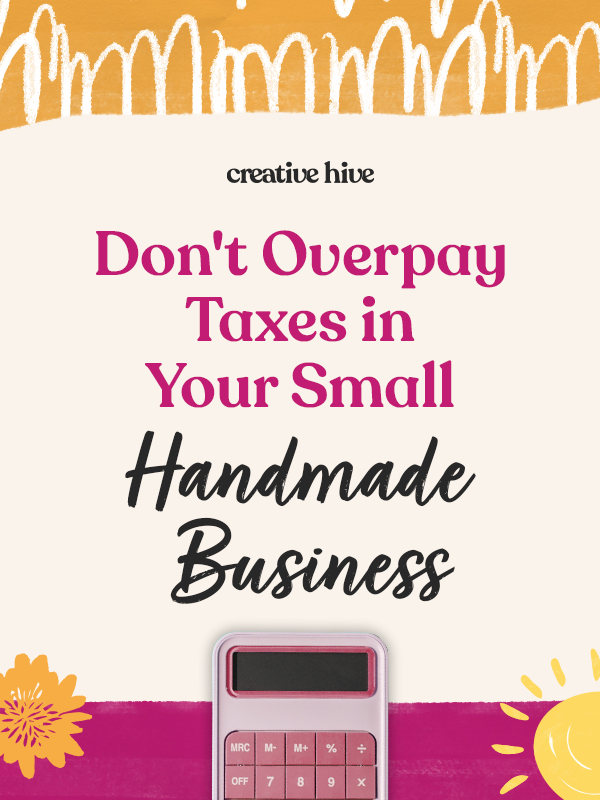I want to help you build a sustainable, profitable handmade business that makes you consistent income and sales. I only ever teach or recommend marketing, social media, pricing, production and branding tips that I’ve personally used successfully in my own 7-figure handmade businesses.
I'm Mei, from Los Angeles!
Read More
Popular Posts You'll Love
Looking for something?
Categories
starting a business
get more traffic
running a business
make more sales
branding
growing a business
mindset & productivity
podcasts
pricing & money
product photography
reviews
selling on etsy
selling on amazon
social media
selling wholesale
- Facebook0
- Twitter0
- Pinterest0
- 0share
Ah, yes. Tax season. The time of the year when running a creative business becomes a nightmare instead of the dream.
Now, I’ve noticed that a lot of myths and misinformation about online business taxes are everywhere on the internet.
Whether you’re a seasoned Shopify seller or a budding Etsy entrepreneur, navigating online business taxes can be confusing.
People say a lot of stuff out there in Facebook groups and Etsy forums about how taxes work for us, but what’s actually true?
That’s why I’m making this blog post.
I want to debunk five common tax myths to get you on the right track and empower you to file with more confidence.
My hope is that, by the end of this post, you’ll know how to avoid tax pitfalls and keep your online business thriving.
Full disclosure though, I am not a financial professional or expert so if you need specific advice to your business or city or state you live in, definitely consult with a professional. I can only share with you what I know based on my own personal experience running multiple creative businesses online since 2006.

Myth #1: I Only Sell Online, So I Don’t Owe Sales Tax
This one can be a costly mistake!
Sales tax laws are based on where your customer lives, not where your business is located.
This is called the economic nexus.
Most states have economic nexus laws that require online sellers to collect and remit sales tax if they have a certain amount of sales or transactions made within that state.
For example, some states require you to collect sales tax if you make more than $100,000 in sales or if you have made more than 200 transactions in that state.
It’s important that you take the time to diligently research the economic nexus laws for the states you sell to.
Fortunately, many online sales platforms like Shopify can automate sales tax collection for you, which can help simplify the process. These platforms can calculate the appropriate rates for each city and state where you’re obligated to collect taxes.
For this, I personally use TaxJar which helps keep track of whether or not I have economic nexus in certain states. It sets the appropriate sales tax percentages for each city and state that I’m collecting tax in, and it even autofiles my sales tax for me for a small fee.
Tools like this ensure my compliance with sales tax regulations while freeing up my valuable time and resources that I could otherwise spend on other aspects of my business.
No more worrying about penalties and headaches! So worth it in my opinion!
Myth #2: Shipping Costs Are Taxable Income
Thankfully, this isn’t true!
Shipping costs incurred in the process of delivering your products to customers are typically regarded as reimbursements for the service provided, rather than taxable income.
This is because you’re not making a profit on shipping.
When setting your shipping rates, consider including a separate line item for the product price and the shipping cost on your invoices and receipts.
In itemizing these expenses, you can establish a clear distinction between revenue generated from sales and reimbursement for shipping services.
This also helps during tax season and avoids any confusion or scrutiny from tax authorities like the IRS.
However, if you happen to already include shipping fees in your product prices, that’s okay too because you’ll still be reporting the shipping expenses you paid for when you file taxes.
Just make sure you are keeping records of all those shipping expenses!
Myth #3: Home Office Deduction? Not for Online Stores
Not necessarily!
If you have a dedicated home office space that’s used exclusively for business purposes, you can claim a home office deduction on your taxes.
The IRS imposes strict guidelines regarding what qualifies as a dedicated space, so be sure to do your research.
Even a small portion of a room can be considered a home office if it’s used regularly and exclusively for business.
Familiarize yourself with IRS regulations on home office deductions to ensure your compliance and so you can maximize potential tax benefits.
Like with everything tax related, keep good records of your home office expenses such as rent or mortgage payment (for the portion of the space you use as an office), utilities, and internet costs.
These can all be factored into your home office deduction calculation.
Myth #4: Inventory Costs Don’t Count Until I Sell Them
While you don’t pay taxes on unsold inventory, you do need to factor it into your taxes using a method called the “cost of goods sold” (COGS).
COGS helps you determine your business’s profitability. It involves subtracting the cost of your inventory from your total sales revenue to derive your business’s gross profit.
There are different inventory valuation methods you can use for COGS calculations, so consulting with a tax professional can be helpful, especially if you have a large inventory.
And, fortunately, there are many accounting software programs available specifically for online businesses that can help you track inventory costs and automate COGS calculations.
So, while it’s true that you don’t pay taxes on unsold inventory, failing to incorporate inventory costs into your tax calculations can lead to inaccuracies in your financial reporting and in complying with tax regulations.
Myth #5: I Can Just Deduct Everything as a Business Expense
Hold up!
While there are many legitimate business expenses you can deduct, the IRS has super specific rules and restrictions on what qualifies as deductible.
Business expenses must be ordinary and necessary for running your online store.
According to the IRS, “An ordinary expense is one that is common and accepted in your industry. A necessary expense is one that is helpful and appropriate for your trade or business.”
So, that new outfit you bought for your product launch video shoot? Probably not deductible, as it could be considered a personal expense rather than an essential business cost.
But the video editing software you use to create those product launch videos? Definitely a deductible expense.
I’ve said it before and I’ll say it again: Keep clear records of your business expenses throughout the year.
Make separate your business bank account and credit card statements from your personal ones.
This will make it much easier to organize your finances, as well as identify and categorize your business expenses come tax time.
Conclusion
Running an online store is exciting, but dealing with taxes can be overwhelming.
If you’re feeling lost or unsure, don’t be afraid to seek help! You are not alone in this.
Many resources are available to online business owners, including:
- The IRS website: The IRS website has a wealth of information for small businesses, including resources specifically for online sellers.
- Tax software: Tax software programs can guide you through the filing process and ensure you’re claiming all the deductions you deserve.
- Tax professionals: Consider consulting with a tax professional who specializes in ecommerce businesses. They can provide personalized advice and ensure you’re on the right track with your online store taxes.
Based on what you’ve learned today: do you now feel prepared and confident in handling your business’ taxes? Let me know in the comments!

Leave a Comment
Liked this article? Share it!
Unlock a Profitable Handmade Business
in Just 12 Weeks Without Using Etsy
or Social Media
FREE WORKSHOP
This workshop is for anyone who makes and sells a handmade or physical product, including jewelry designers, artists, paper designers, bath & body product makers and more!
What You'll Discover
The #1 mistake people make with Etsy & social media that causes shops to FLOP
The secret to making it with your handmade shop so it's no longer just a hobby
How to make sales in your handmade shop with ease so you can finally get to 6-figures
TAKE ME THERE
Leave a Reply Cancel reply
About
Blog
A Sale A Day
Student Login
Free Class
Contact
Terms
Become A Student
Watch On YouTube
Student Reviews
See My Handmade Shop!



Your email address will not be published. Required fields are marked *